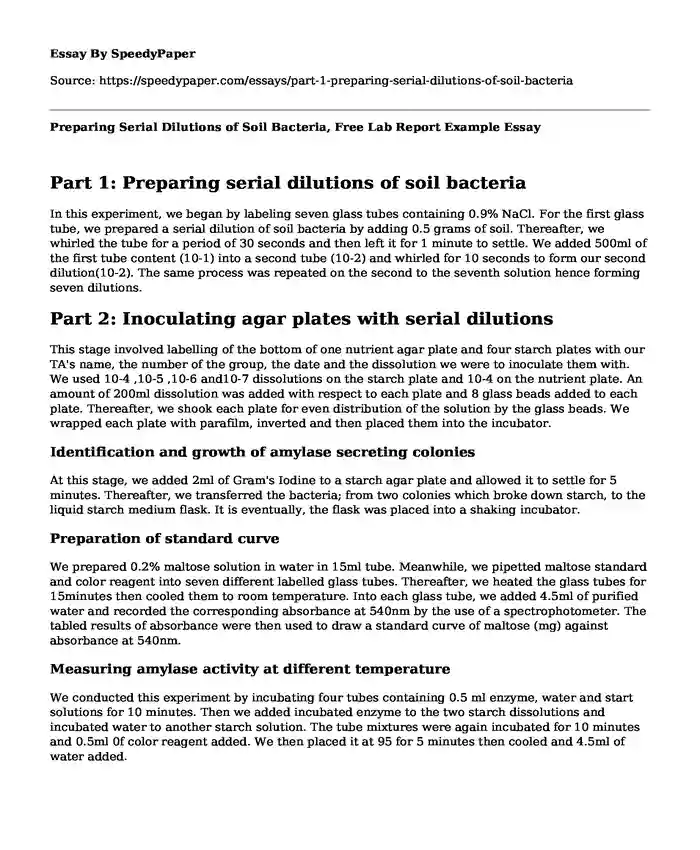Part 1: Preparing serial dilutions of soil bacteria
In this experiment, we began by labeling seven glass tubes containing 0.9% NaCl. For the first glass tube, we prepared a serial dilution of soil bacteria by adding 0.5 grams of soil. Thereafter, we whirled the tube for a period of 30 seconds and then left it for 1 minute to settle. We added 500ml of the first tube content (10-1) into a second tube (10-2) and whirled for 10 seconds to form our second dilution(10-2). The same process was repeated on the second to the seventh solution hence forming seven dilutions.
Part 2: Inoculating agar plates with serial dilutions
This stage involved labelling of the bottom of one nutrient agar plate and four starch plates with our TA's name, the number of the group, the date and the dissolution we were to inoculate them with. We used 10-4 ,10-5 ,10-6 and10-7 dissolutions on the starch plate and 10-4 on the nutrient plate. An amount of 200ml dissolution was added with respect to each plate and 8 glass beads added to each plate. Thereafter, we shook each plate for even distribution of the solution by the glass beads. We wrapped each plate with parafilm, inverted and then placed them into the incubator.
Identification and growth of amylase secreting colonies
At this stage, we added 2ml of Gram's Iodine to a starch agar plate and allowed it to settle for 5 minutes. Thereafter, we transferred the bacteria; from two colonies which broke down starch, to the liquid starch medium flask. It is eventually, the flask was placed into a shaking incubator.
Preparation of standard curve
We prepared 0.2% maltose solution in water in 15ml tube. Meanwhile, we pipetted maltose standard and color reagent into seven different labelled glass tubes. Thereafter, we heated the glass tubes for 15minutes then cooled them to room temperature. Into each glass tube, we added 4.5ml of purified water and recorded the corresponding absorbance at 540nm by the use of a spectrophotometer. The tabled results of absorbance were then used to draw a standard curve of maltose (mg) against absorbance at 540nm.
Measuring amylase activity at different temperature
We conducted this experiment by incubating four tubes containing 0.5 ml enzyme, water and start solutions for 10 minutes. Then we added incubated enzyme to the two starch dissolutions and incubated water to another starch solution. The tube mixtures were again incubated for 10 minutes and 0.5ml 0f color reagent added. We then placed it at 95 for 5 minutes then cooled and 4.5ml of water added.
Determining if isolated bacteria have amylase activity
In this experiment, we incubated four tubes containing 0.5 ml water, enzyme and two starch solutions for 10minutes. We then added incubated enzymes to the starch solutions and again water to another starch solution. They were then incubated for 10minutes and 0.5 ml of color reagent added, placed at a temperature of 95 for 5minutes. Thereafter, we cooled the tubes to room temperature then added 4.5 ml of water. We incubated the control and experimental tubes to 74 for 10minutes then added color reagent; followed by another incubation at 95 for 5 minutes. We followed by cooling it and making observations.
Cite this page
Preparing Serial Dilutions of Soil Bacteria, Free Lab Report Example. (2022, Mar 24). Retrieved from https://speedypaper.net/essays/part-1-preparing-serial-dilutions-of-soil-bacteria
Request Removal
If you are the original author of this essay and no longer wish to have it published on the SpeedyPaper website, please click below to request its removal:
- Article Critique Sample: Enslavement and Industrialization
- Assignments on the US Constitution, Free Paper
- Forensic Archaeology - Free Essay for Your Inspiration
- Journal Article Review: What Happens When You Outsource Too Much
- Quality Measurement Strategies
- Essay Example on Issues in Society Arose Due the Internet and Social Media
- Paper Example. Kidney Trade Puzzle
Popular categories





